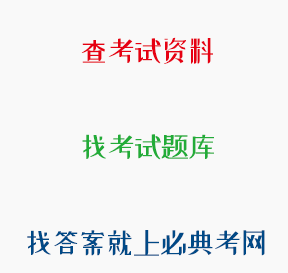正确答案: C
创造性
题目:在教育过程中,教师对突发性事件做出迅速、恰当的处理被称为教育机智。这反映了教师劳动的哪一特点?( )
解析:教师劳动的创造性体现在:因材施教、教学上的不断更新和"教育机智"。在教育的过程中意外的事情总会发生。教师在无准备的情况下能迅速果断的做出判断,随机应变,因势利导是教师教育机智的表现。故选择C项。
查看原题 查看所有试题
学习资料的答案和解析:
[单选题]下列选项中,不属于中医学著作的是( )。
《齐民要术》
解析:《齐民要术》是由北朝北魏农学家贾思勰写成的中国现存的最早的、最完整的大型农业百科全书,不是医学著作。故选择C。A选项,《神农本草经》是我国第一部完整的药物学著作。B选项,《本草纲目》是李时珍所著的医学著作。D选项,《黄帝内经》与、《难经》、《伤寒杂病论》、《神农本草经》并称为中国传统医学四大经典著作。
[单选题]首次提出教育遵循自然的观点的是( )。
亚里士多德
解析:古希腊哲学家亚里士多德主张应该按照儿童心理发展规律对儿童分阶段进行教育,他首次提出了教育遵循自然"的观点。故选择B。A项,柏拉图是古希腊伟大的哲学家,也是全部西方哲学乃至整个西方文化最伟大的哲学家和思想家之一。西方教育史上第一个提出完整的学前教育思想并建立了完整的教育体系的人。C项,昆体良是古代罗马著名的教育家。他是教育史上大大发展完善教育方法和思想的先驱。著有《演说术原理》-书,是古代西方第一部系统的教学方法论著,不仅反映了公元前后二百年间罗马学校教育的实际,而且系统地阐述了关于培养演说家的教育思想。D项,苏格拉底在教学的方法上通过长期的教学实践,形成了自己一套独特的教学法,人们称之为"苏格拉底方法",他本人则称之为"产婆术"。
[多选题]下列关于学校文化所具有的特点的表述,正确的有( )。
它是以有形的物质为载体的无形文化
它是一种具有相对稳定性和连续性的文化
它是一种有个性的文化
它是一种软约束性的文化
解析:学校文化的特点:(1)学校文化是以有形的物质为载体的无形文化;(2)学校文化是一种软约束性的文化;(3)学校文化是一种具有相对稳定性和连续性的文化;(4)学校文化是一种有个性的文化。
[单选题]涂尔干说"教育是成年一代对社会生活尚未成熟的年轻一代所实施的影响,其目的在于,使儿童的身体,智力和道德状况都得到激励与发展,以适应整个政治社会在总体上对儿童的要求,并适应儿童将来所处的特定环境的要求"这种诊断正确的指出了( )。
教育具有社会性
解析:社会本位教育目的论的观点是:从社会发展需要出发,注重教育的社会价值;主张教育的目的是培养合格公民和社会成员;教育是国家的事业;评价教育要看其对社会的发展贡献的指标。代表人物有:赫尔巴特、柏拉图、孔德、涂尔干等。涂尔干的话中表明要教育的目的是使儿童的发展适应社会的要求,体现了教育具有社会性。故选择C。
[多选题]现代课程开发理论中的经典"泰勒原理"所回应的问题有( )。
学校应该试图达到什么教育目标
提供什么教育经验最有可能达到的目标
怎样有效地组织这些教育经验
我们如何确定这些教育目标正在得以实现
解析:泰勒在《课程与教学的基本原理》-书中开宗明义地指出,开发任何课程和教学计划都必须回答个基本问题:①学校应该试图达到什么教育目标?②提供什么教育经验最有可能达到这些目标?⑧怎样有效地组织这些教育经验?④我们如何确定这些目标正在得以实现?
[单选题]由组织正式文件明文规定的、群体成员有固定的编制,有规定的权力和义务,有明确的职责和分工的群体属于( )。
正式群体
解析:正式群体是指为了达到与组织任务有明确关系的特定目标,根据编制、章程或其他要求正式成立的群体。如学校的班级就是正式群体。故选择B。
[单选题] The use of deferential language is symbolic of the Confucian ideal of the woman, which dominates conservative gender norms in Japan. This ideal presents a woman who withdraws quietly to the background, subordinating her life and needs to those of her family and its male head. She is a dutiful daughter, wife, and mother, master of the domestic arts. The typical refined Japanese woman excels in modesty and delicacy; she "treads softly in the world," elevating feminine beauty and grace to an art form.
Nowadays, it is commonly observed that young women are not conforming to the feminine linguistic ideal. They are using fewer of the very deferential "women's" forms, and even using the few strong forms that are known as "men's." This, of course, attracts considerable attention and has led to an outcry in the Japanese media against the defeminization of women's language. Indeed, we didn't hear about "men's language" until people began to respond to girls' appropriation of forms normally reserved for boys and men. There is considerable sentiment about the "corruption" of women's language-which of course is viewed as part of the loss of feminine ideals and morality-and this sentiment is crystallized by nationwide opinion polls that are regularly camed out by the media.
Yoshiko Matsumoto has argued that young women probably never used as many of the highly deferential forms as older women. This highly polite style is no doubt something that young women have been expected to "grow into"-after all, it is assign not simply of femininity, but of maturity and refinement, and its use could be taken to indicate a change in the nature of one's social relations as well. One might well imagine little girls using exceedingly polite forms when playing house or imitating older women-in a fashion analogous to little girls' use of a high-pitched voice to do "teacher talk" or "mother talk" in role play.
The fact that young Japanese women are using less deferential language is a sure sign of change-of social change and of linguistic change. But it is most certainly not a sign of the "masculization" of girls. In some instances, it may be a sign that girls are making the same claim to authority as boys and men, but that is very different from saying that they are trying to be "masculine." Katsue Reynolds has argued that girls nowadays are using more assertive language strategies in order to be able to compete with boys in schools arid out. Social change also brings not simply different positions for women and girls, but different relations to life stages, and adolescent girls are participating in new sub-cultural forms. Thus what may, to an older speaker, seem like "masculine" speech may seem to an adolescent like "liberated" or "hip" speech.
Today, young Japanese women have some changes in ________ from the traditional ones.
the deferential linguistic forms
解析:1.细节题。文中第一段提到了典型的日本女人受到孔子思想的影响,谦虚、优雅;只有 C选项不是日本女人的典型特征,故选C。
2.细节题。文中最后一段提到“The fact that young Japanese women are using less deferential language is a sure sign of change”即年轻女人使用的语言不再那么顺从,与B选项吻合,故选B。
3.细节题。文中第二段提到“This,of course,attracts considerable attention and has led to an outcry in the Japanese media against the defeminization of women's language”即日本媒体强烈反对女性用语中的去女性化现象。故选A。
4.细节题。文中第三段提到“…it is assign not simply of femininity, but of maturity and refinement, and its use could be taken to indicate a change in the nature of one's social relations as well.”即高度有礼貌的语言被视为一种成熟和文雅,选项C符合题意。
5.细节题。文章最后一段提到“Katsue Reynolds has argued that girls nowadays are using more assertive language strategies in order to be able to compete with boys in schools and out"选项A符合题意,故选A。
[单选题]Which of the following practices can encourage students to read an article critically?
Evaluating its point of view.
解析:本题考查阅读教学。题干:下列哪种练习可以鼓励学生批判性地阅读文章?A项“评价它的观点”,B项“找出事实”,c项为“找到细节信息”,D项“做翻译练习”。评价文章观点的活动能够引导学生在理解文本的基础上对文章中的观点进行分析、评判,促使学生主动、积极地思考,促进学生批判性思维的发展。故本题选A。

 川公网安备 51012202001360号
川公网安备 51012202001360号